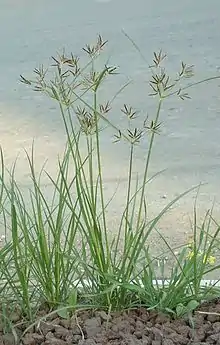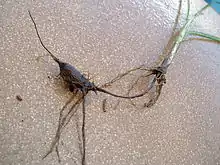Cyperus rotundus
Cyperus rotundus (coco-grass, Java grass, nut grass, purple nut sedge[2] or purple nutsedge,[3] red nut sedge, Khmer kravanh chruk[4]) is a species of sedge (Cyperaceae) native to Africa, southern and central Europe (north to France and Austria), and southern Asia. The word cyperus derives from the Greek κύπερος, kyperos,[5] and rotundus is from Latin, meaning "round".[6] The earliest attested form of the word cyperus is the Mycenaean Greek 𐀓𐀞𐀫, ku-pa-ro, written in Linear B syllabic script.[7]
| Coco-grass | |
|---|---|
 | |
| Scientific classification | |
| Kingdom: | Plantae |
| Clade: | Tracheophytes |
| Clade: | Angiosperms |
| Clade: | Monocots |
| Clade: | Commelinids |
| Order: | Poales |
| Family: | Cyperaceae |
| Genus: | Cyperus |
| Species: | C. rotundus |
| Binomial name | |
| Cyperus rotundus | |
Cyperus rotundus is a perennial plant, that may reach a height of up to 140 cm (55 in). The names "nut grass" and "nut sedge" – shared with the related species Cyperus esculentus – are derived from its tubers, that somewhat resemble nuts, although botanically they have nothing to do with nuts.
As in other Cyperaceae, the leaves sprout in ranks of three from the base of the plant, around 5–20 cm (2–8 in) long. The flower stems have a triangular cross-section. The flower is bisexual and has three stamina and a three-stigma pistil, with the inflorescence having three to eight unequal spikes. The fruit is a three-angled achene.
Young plants initially form white, fleshy rhizomes, up to 25 mm (1.0 in) in dimension, in chains. Some rhizomes grow upward in the soil, then form a bulb-like structure from which new shoots and roots grow, and from the new roots, new rhizomes grow. Other rhizomes grow horizontally or downward, and form dark reddish-brown tubers or chains of tubers.
It prefers dry conditions, but will tolerate moist soils, and often grows in wastelands and in crop fields.[4]
History

C. rotundus was part of a set of starchy tuberous sedges that may have been eaten by Pliocene hominins.[8] Biomarkers and microscopic evidence of C. rotundus are present in human dental calculus found at the Al Khiday archaeological complex in central Sudan dating from before 6700 BC to the Meroitic pre-Islamic Kingdom of 300–400 AD. It is suggested that C. rotundus consumption may have contributed to the relatively low frequency of dental caries among the Meroitic population of Al Khiday because of its ability to inhibit Streptococcus mutans.[8]
C. rotundus was employed in ancient Egypt, Mycenean Greece, and elsewhere as an aromatic and to purify water. It was used by ancient Greek physicians Theophrastus, Pliny the Elder, and Dioscorides as both medicine and perfume.[8]
Uses


C. rotundus has many beneficial uses. It is a staple carbohydrate in tropical regions for recent hunter-gatherers and is a famine food in some agrarian cultures.[9]
Folk medicine
In traditional Chinese medicine, C. rotundus is considered the primary qi-regulating herb.
The plant is mentioned in the ancient Indian ayurvedic medicine Charaka Samhita (circa 100 AD). Modern ayurvedic medicine uses the plant, known as musta or musta moola churna,[10][11] for fevers, digestive system disorders, dysmenorrhea, and other maladies.
Arabs of the Levant traditionally use roasted tubers, while they are still hot, or hot ashes from burned tubers, for wounds, bruises, and carbuncles. Western and Islamic herbalists including Dioscorides, Galen, Serapion, Paulus Aegineta, Avicenna, Rhazes, and Charles Alston have described its use as a stomachic, emmenagogue, and deobstruent, and in emollient plasters.[12][13]
The antibacterial properties of the tubers may have helped prevent tooth decay in people who lived in Sudan 2000 years ago. Less than 1% of that local population's teeth had cavities, abscesses, or other signs of tooth decay, though those people were probably farmers (early farmers' teeth typically had more tooth decay than those of hunter-gatherers because the high grain content in their diet created a hospitable environment for bacteria that flourish in the human mouth, excreting acids that eat away at the teeth).[14][15]
Modern uses and studies
Several chemical substances have been identified in C. rotundus: cadalene, cyprotene, flavonoids, sesquiterpenes, terpenoids, mustakone, isocyperol, acyperone, rotundene, valecine,[16] kaempferol, luteolin, quercetin, patchoulenone, isopatchoulenone, sugeonyl acetate, cellulose triacetate and sugebiol.[17] A sesquiterpene, rotundone, so called because it was originally extracted from the tuber of this plant, is responsible for the spicy aroma of black pepper and the peppery taste of certain Australian Shiraz wines.[18]
Extract from leaves and tubers of Cyperus rotundus L. increase the adventitious rooting of different species. These extracts contain a large amount of auxins and phenolic compounds that promote the rooting of cuttings and seedlings.[19][20]
Food

Despite the bitter taste of the tubers, they are edible and have nutritional value. Some part of the plant was eaten by humans between Mesolithic and Neolithic periods.[21] The plant has a high amount of carbohydrates.[22] The plant is eaten in Africa in famine-stricken areas.
In addition, the tubers are an important nutritional source of minerals and trace elements for migrating birds such as cranes.[23]
Sleeping mats
The well dried coco grass is used in mats for sleeping.
Invasive problems and eradication

Cyperus rotundus is one of the most invasive weeds known, having spread out to a worldwide distribution in tropical and temperate regions. It has been called "the world's worst weed"[24] as it is known as a weed in over 90 countries, and infests over 50 crops worldwide.[25] In the United States it occurs from Florida north to New York and Minnesota and west to California and most of the states in between. In the uplands of Cambodia, it is described as an important agricultural weed.[4]
Its existence in a field significantly reduces crop yield, both because it is a tough competitor for ground resources, and because it is allelopathic, the roots releasing substances harmful to other plants.[26] Similarly, it also has a bad effect on ornamental gardening. The difficulty to control it is a result of its intensive system of underground tubers, and its resistance to most herbicides. It is also one of the few weeds that cannot be stopped with plastic mulch.

Weed pulling in gardens usually results in breakage of roots, leaving tubers in the ground from which new plants emerge quickly. Ploughing distributes the tubers in the field, worsening the infestation; even if the plough cuts up the tubers to pieces, new plants can still grow from them. In addition, the tubers can survive harsh conditions, further contributing to the difficulty to eradicate the plant. Hoeing in traditional agriculture of South East Asia does not remove the plant but leads to rapid regrowth.[4]
Most herbicides may kill the plant's leaves, but most have no effect on the root system and the tubers. Glyphosate will kill some of the tubers (along with most other plants) and repeated application can be successful. Halosulfuron-methyl[27] will control nut grass after repeated applications without damaging lawns.[28] The plant does not tolerate shading and 2,4-dichlorophenoxyacetic acid (2,4-D) slows its growth in pastures and mulch crops.
References
- Lansdown, R.V., Juffe Bignoli, D. & Beentje, H.J. (2017). Cyperus rotundus. The IUCN Red List of Threatened Species 2017: e.T158183A84284983. Downloaded on 27 October 2018.
- "Cyperus rotundus (sedge)". Retrieved 2019-04-24.
- "BSBI List 2007". Botanical Society of Britain and Ireland. Archived from the original (xls) on 2015-01-25. Retrieved 2014-10-17.
- Martin, Robert & Pol Chanthy, 2009, Weeds of Upland Cambodia Archived 2014-02-25 at the Wayback Machine, ACIAR Monagraph 141, Canberra.
- κύπερος. Liddell, Henry George; Scott, Robert; A Greek–English Lexicon at the Perseus Project.
- rotundus. Charlton T. Lewis and Charles Short. A Latin Dictionary on Perseus Project.
- "The Linear B word ku-pa-ro". Palaeolexicon. Word study tool of ancient languages.
- Buckley, Stephen; Usai, Donatella; Jakob, Tina; Radini, Anita; Hardy, Karen (2014). "Dental Calculus Reveals Unique Insights into Food Items, Cooking and Plant Processing in Prehistoric Central Sudan". PLoS ONE. 9 (7): e100808. Bibcode:2014PLoSO...9j0808B. doi:10.1371/journal.pone.0100808. PMC 4100759. PMID 25028938.
- Bhandari, MM (1974). "Famine Foods in the Rajasthan Desert". Economic Botany. 28 (1): 78. doi:10.1080/09735070.2010.11886369. S2CID 131037079.
- Jagtap, A. G.; Shirke, S. S.; Phadke, A. S. (February 2004). "Effect of polyherbal formulation on experimental models of inflammatory bowel diseases". Journal of Ethnopharmacology. 90 (2–3): 195–204. doi:10.1016/j.jep.2003.09.042. PMID 15013181.
- Manish V. Patel; et al. (October 2010). "Effects of Ayurvedic treatment on forty-three patients of ulcerative colitis". Ayu. 31 (4): 478–481. doi:10.4103/0974-8520.82046. PMC 3202252. PMID 22048543.
- Aegineta Paulus (translation and commentary by Francis Adams) (1847). The seven books of Paulus Aegineta: Translated from the Greek.
- Charles Alston (1770). Lectures on the materia medica: containing the natural history of drugs.
- Traci Watson (July 16, 2014). "Ancient People Achieved Remarkably Clean Teeth With Noxious Weed". National Geographic. Retrieved 2019-04-24.
- Feltman, Rachel (July 17, 2014). "Ancient humans may have eaten a pesky weed to fight off cavities". The Washington Post. Retrieved 2019-04-24.
- Imam, Hashmat; Sofi, Ghulamuddin; Seikh, Aziz; Lone, Azad (2004). "The incredible benefits of Nagarmotha (Cyperus rotundus)". International Journal of Nutrition, Pharmacology, Neurological Diseases. 4 (1): 23–27. doi:10.4103/2231-0738.124611.
- Ying, J.; Bing, X. (2016). "Chemical constituents of Cyperus rotundus L. and their inhibitory effects on uterine fibroids". African Health Sciences. 16 (4): 1000–1006. doi:10.4314/ahs.v16i4.16. PMC 5398446. PMID 28479892.
- Siebert, Tracey E; Wood, Claudia; Elsey, Gordon M; Pollnitz, Alan P. (2008). "Determination of Rotundone, the Pepper Aroma Impact Compound, in Grapes and Wine". Journal of Agricultural and Food Chemistry. 56 (10): 3745–8. doi:10.1021/jf800184t. PMID 18461962.
- Rezende, F.P.F; Zuffellato-Ribas, K.C; Koehler, H.S (2013). "Aplicação de extratos de folhas e tubérbulos de Cyperus rotundus L. E de auxinas sintéticas na estaquia caulinar de Duranta repens L" [Application of extracts of leaves and tubers of Cyperus rotundus L. and of synthetic auxins in the cutting stem of Duranta repens L]. Revista Brasileira de Plantas Medicinais (in Portuguese). 15 (4 suppl 1): 639. doi:10.1590/S1516-05722013000500003.
- Yamashita, Oscar Mitsuo; Azevedo, Gustavo Waddan Perez; Peres, Walmor Moya; David, Grace Queiroz; Carvalho, Marco Antonio Camillo de; Koga, Paulo Sergio (2017). "Seedling Production of Fruit and Ornamental Species to the Use of Weed Harmone (Cyperus rotundus)". Nucleus. 14: 279–288. doi:10.3738/1982.2278.1988.
- Buckley, Stephen; Usai, Donatella; Jakob, Tina; Radini, Anita; Hardy, Karen (2014). "Dental Calculus Reveals Unique Insights into Food Items, Cooking and Plant Processing in Prehistoric Central Sudan". PLoS ONE. 9 (7): e100808. Bibcode:2014PLoSO...9j0808B. doi:10.1371/journal.pone.0100808. PMC 4100759. PMID 25028938.
- "Tooth plaque provides unique insights into our prehistoric ancestors' diet". ScienceDaily.
- Meine, Curt; Archibald, George, eds. (1996). The Cranes: Status Survey and Conservation Action Plan. p. 96. ISBN 2-8317-0326-3.
- Holm, LeRoy G.; Plucknett, Donald L..; et al. (1977). The World's worst weeds: Distribution and biology. Hawaii: University Press of Hawaii.
- Omezine, Abdessatar; Harzallah-Skhili, Fethia (2009). "Biological Behavior of Cyperus rotundus in Relation to Agro-Ecological Conditions and Imposed Human Factors". African Journal of Plant Science and Biotechnology. Global Science Books.
- Darmanti, Sri; Dewi, Kumala; L. Hartanto Nugroho (December 2015). "Allelopathic Effect of Cyperus rotundus L. on Seed Germination and Initial Growth of Glycine max L. cv. Grobogan". 17 (2): 61–67. Cite journal requires
|journal=(help) - "USDOE-Bonneville Power Administration, Halosulfron-methyl Herbicide Fact Sheet, March 2000" (PDF). Archived from the original (PDF) on 2011-10-19. Retrieved 2012-06-12.
- Nutgrass – a tough little nut to crack, January 2016
External links
| Wikimedia Commons has media related to Cyperus rotundus. |
- Flora Europaea: Cyperus rotundus
- USDA Plants Profile: Cyperus rotundus
- USDA Natural Resources Conservation Service: Cyperus rotundus (pdf file)
- Use in Chinese and Ayurvedic medicine
- A Tel-Aviv University study mentioning its nutritional importance for migrating birds (in Hebrew)
- Caldecott, Todd (2006). Ayurveda: The Divine Science of Life. Elsevier/Mosby. ISBN 978-0-7234-3410-8. Contains a detailed monograph on Cyperus rotundus (Musta; Mustaka) as well as a discussion of health benefits and usage in clinical practice. Available online at https://web.archive.org/web/20110616192931/http://www.toddcaldecott.com/index.php/herbs/learning-herbs/310-musta
